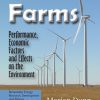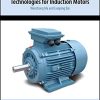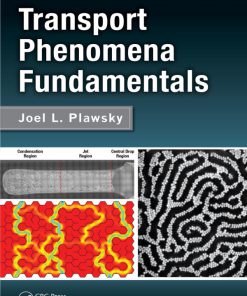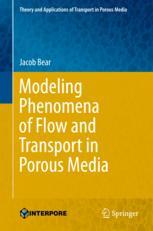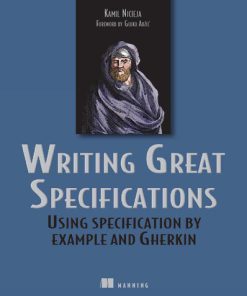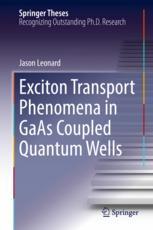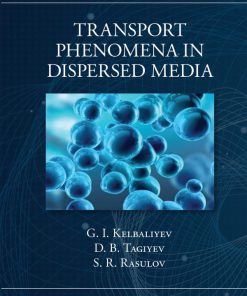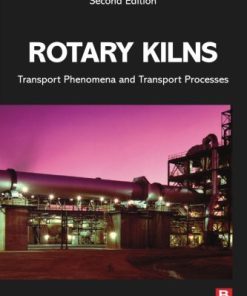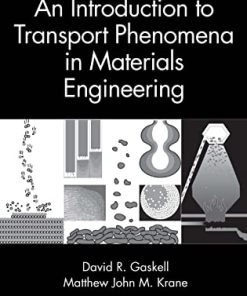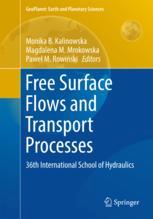Transport and Surface Phenomena 1st Edition Kamil Wichterle 0128189959 9780128189955
$50.00 Original price was: $50.00.$25.00Current price is: $25.00.
This completed downloadable of Transport and Surface Phenomena 1st Edition Kamil Wichterle
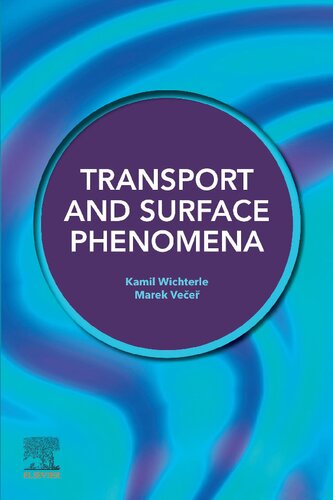
Instant downloaded Transport and Surface Phenomena 1st Edition Kamil Wichterle pdf docx epub after payment.
Product details:
- ISBN 10: 0128189959
- ISBN 13: 9780128189955
- Author: Kamil Wichterle
Transport and Surface Phenomena provides an overview of the key transfers taking place in reactions and explores how calculations of momentum, energy and mass transfers can help researchers develop the most appropriate, cost effective solutions to chemical problems. Beginning with a thorough overview of the nature of transport phenomena, the book goes on to explore balances in transport phenomena, including key equations for assessing balances, before concluding by outlining mathematical methods for solving the transfer equations. Drawing on the experience of its expert authors, it is an accessible introduction to the field for students, researchers and professionals working in chemical engineering.
Table of contents:
Chapter One: Definitions of unidirectional steady transport
Abstract
1.1 Steady unidirectional transport of heat by conduction
1.2 Steady unidirectional transfer of mass by diffusion
1.3 Steady unidirectional transfer of momentum by viscous friction in fluids
1.4 Similarities and differences
1.5 Summary
Chapter Two: Transport phenomena in terms of mass structure
Abstract
2.1 Molecular theory of transport phenomena in gases
2.2 Transport phenomena in gases
2.3 Momentum transport in solids and liquids
2.4 Rheology
2.5 What happens while straining condensed materials?
2.6 Heat transfer by conduction in liquids and solids
2.7 Transport of mass by diffusion in liquids and solids
2.8 Summary
Chapter Three: Transport phenomena at the interface
Abstract
3.1 The working of the forces at the interface
3.2 Mechanical equilibrium between phases
3.3 Heat equilibrium between phases
3.4 Equilibrium concentrations between phases
3.5 Summary
Chapter Four: Transport of energy by radiation
Abstract
4.1 Types of radiation
4.2 Heat radiation and its absorption
4.3 Transmission of heat by radiation through a mass medium
4.4 Radiation in chemical analysis
4.5 Summary
Chapter Five: Experimental methods for the study of transport phenomena
Abstract
5.1 Mechanical quantities
5.2 Thermal quantities
5.3 Summary
Chapter Six: Simple problems in heat transport
Abstract
6.1 One-dimensional steady conduction of heat
6.2 Steady conduction of heat with a source of heat
6.3 Steady heat conduction through a composite layer
6.4 Summary
Chapter Seven: Simple problems in fluid flows
Abstract
7.1 Viscometric flows
7.2 The flow in straight tubes
7.3 Rotary flow along a moving boundary
7.4 Measurement of viscosity by nonviscometric setups
7.5 Summary
Chapter Eight: Fundamentals of the fluid mechanics
Abstract
8.1 Plane forces, stress tensor, and its components
8.2 Three-dimensional generalization of Newton’s law of viscosity
8.3 Rheology
8.4 Summary
Chapter Nine: Transports in moving media
Abstract
9.1 Mass balances—The equation of continuity
9.2 Momentum balances in terms of stresses: Cauchy equation
9.3 Inertial set
9.4 The momentum balance in a fluid having a constant density and viscosity: Navier-Stokes (N-S) equation
9.5 Summary
Part Two: Balances in transport phenomena
Chapter Ten: Solutions of the Navier-Stokes equation
Abstract
10.1 Cartesian coordinate set
10.2 Cylindrical coordinate set
10.3 Spherical coordinate set
10.4 Non-inertial rotating set
10.5 The estimation of the importance of the individual terms in the Navier-Stokes equation. The Reynolds number
10.6 The effect of the Reynolds number
10.7 Characteristic hydrodynamic quantities
10.8 The boundary and initial conditions
10.9 Summary
Chapter Eleven: The balance of mass and of mechanical energy in a flow tube
Abstract
11.1 The integral equation of continuity and the Bernoulli equation
11.2 The losses of mechanical energy by friction
11.3 The basic equations of hydrostatics
11.4 Summary
Chapter Twelve: The steady unidirectional flow
Abstract
12.1 The steady one-dimensional unidirectional creeping flow
12.2 Possible solutions of the equation of flow in terms of stresses
12.3 Solving the problems in stresses
12.4 Two-dimensional unidirectional flows
12.5 The principle of the minimal entropy rise
12.6 Instability of the creeping flow
12.7 Summary
Chapter Thirteen: The basics of steady heat conduction and diffusion
Abstract
13.1 The three-dimensional Fourier’s law
13.2 Three-dimensional Fick’s law
13.3 The heat conduction
13.4 The equation of the mass transport
13.5 Qualitative aspects of transport phenomena
13.6 Summary
Chapter Fourteen: Unidirectional unsteady transfer
Abstract
14.1 Unidirectional unsteady transfer in half-space
14.2 Unidirectional unsteady transfer in half-space
14.3 The integral parameters of heat conduction
14.4 One-directional unsteady transfer in a finite space
14.5 Summary
Chapter Fifteen: The flow in two dimensions
Abstract
15.1 The stream function
15.2 Combination of inviscid and creeping flow
15.3 The flow past bodies: The boundary layer
15.4 The generalization of the boundary layer concept
15.5 The flow past realistic bodies
15.6 The entry section of a pipe
15.7 Flow past bubbles and drops
15.8 Summary
Chapter Sixteen: Extension of balances to turbulent flows
Abstract
16.1 Termination of laminar flow
16.2 The solution of the equations of motion in the turbulent regime
16.3 The averaged flow. Reynolds stresses
16.4 The influence of large eddies
16.5 The turbulent transfer of heat and mass
16.6 Summary
Chapter Seventeen: Solution of the equation of convection
Abstract
17.1 Heat transfer in a pipe
17.2 The solution for a constant wall temperature
17.3 The Nusselt number
17.4 The solution for constant heat flow through a wall
17.5 The generalization for more realistic boundary conditions
17.6 The heat transfer in a boundary layer
17.7 Heat transfer in a turbulent flow
17.8 The Chilton-Colburn analogy
17.9 Summary
Chapter Eighteen: Mutually influenced transfer of momentum and heat
Abstract
18.1 Free (natural) convection
18.2 Nonisoviscous (“nonisothermal”) flow
18.3 The influence of expansion
18.4 The dissipation of mechanical energy
18.5 Summary
Part Three: Mathematical methods for solving the transfers
Chapter Nineteen: Vectors and tensors
Abstract
19.1 Vectors
19.2 The derivative of a vector
19.3 Tensors
Chapter Twenty: Some ordinary differential equations
Abstract
20.1 Equations of the first order
20.2 Second-order equations
20.3 Numerical solution
Chapter Twenty-One: Some partial differential equations
Abstract
21.1 Numerical integration
21.2 Analytical solution
Appendix
Biographical notes
Sir Isaac Newton (1643–1728)
Jean Baptiste Joseph Fourier (1768–1830)
Daniel Bernoulli (1700–82)
Leonhard Euler (1707–83)
Claude-Louis Navier (1785–1836)
Augustin Louis Cauchy (1789–1857)
Jean Léonard Marie Poiseuille (1797–1869)
Sir George Gabriel Stokes (1819–1903)
Gustav Robert Kirchhoff (1824–87)
Franz Grashof (1826–93)
Adolf Eugen Fick (1829–1901)
Osborne Reynolds (1842–1912)
Ludwig Boltzmann (1844–1906)
Nikolay Yegorovich Zhukovsky (1847–1921)
Ludwig Prandtl (1875–1953)
Theodore von Kármán (1881–1963)
Ernst Kraft Wilhelm Nusselt (1882–1957)
Andrey Nikolajevich Kolmogorov (1903–87)
Alexey Vasilievich Luikov (1910–74)
People also search:
transport phenomena solution manual
transport phenomena
transport phenomena equations
transport phenomena in porous media
transport phenomena bsl
You may also like…
Engineering - Chemical Engineering
Transport Phenomena Fundamentals 4th Edition Joel L. Plawsky
Computers - Programming
Writing Great Specifications: Using Specification by Example and Gherkin 1st Edition Kamil Nicieja
Engineering
Exciton Transport Phenomena in GaAs Coupled Quantum Wells 1st Edition Jason Leonard (Auth.)
Engineering - Industrial Engineering & Materials Science
An Introduction to Transport Phenomena in Materials Engineering 3rd Edition Gaskell


